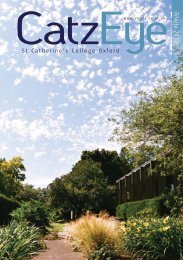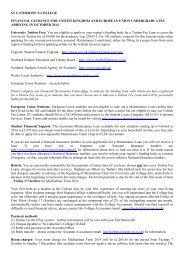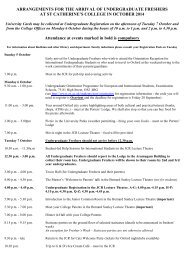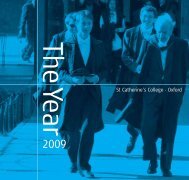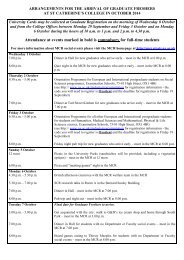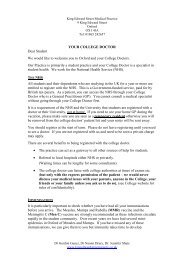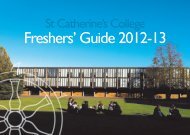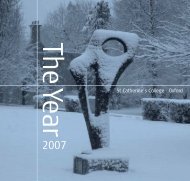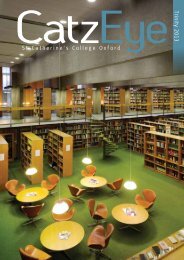GAZETTEEmeritus Fellow Henry Bennet-Clark remembers Founding FellowLloyd <strong>St</strong>ocken,the <strong>College</strong>’s first Tutor in BiochemistryLloyd arrived in Oxford in 1937, and wassoon put to work finding an antidote tothe chemical poison Lewisite. In the climateof the late 1930s, the threat of chemicalwarfare was very real: both chlorine gasand mustard gas had been used in the latterpart of the First World War with devastatingeffect and there had been suggestions thatLewisite had later been used by Japan againstChina. By 1941, Lloyd, working with RobertThompson under the direction of SirRudolf Peters, had developed an antidote,Dimercaprol, or British anti-Lewisite (BAL),which was totally effective, even wheninjected up to half an hour after exposureto the poison. BAL works by attaching itselfto heavy metals such as lead, mercury and,crucially in this case, arsenic, allowingthem to be excreted safely from the body.There was considerable strategic advantagein having an effective antidote to such aknown chemical hazard, and the discoverywas instantly declared top secret, with theconsequence that although awarded his DPhilin 1943, Lloyd was not allowed to publish histhesis until 1947. The first paper by Peters,<strong>St</strong>ocken and Thompson announcing theirdiscovery was published in Nature in 1945;it continues to be widely cited. Lloyd followedthis early success with research on the modeof action of BAL, which was published in thelate 1940s.The 1950s saw a shift in the focus of Lloyd’sresearch on the effects of radiation on cellularmetabolic processes, and it was at this timethat he began a long collaboration withMargery Ord. This was a time when therewas considerable interest in cellularbiochemistry – but before the ‘double helix’had made its impact, and the study of Biologyat a molecular level had become widespread.Over the decade that followed, Lloyd andMargery published a series of papers on thebiochemical effects of radiation on cellularprocesses, particularly on histones, whichare now known to be important structuralelements in the organisation of genes.In 1998, Lloyd and Margery editedFoundations of Modern Biochemistry: A Multi-Volume Treatise and in 2006, when Lloyd wasThe 1950s saw a shift inthe focus of Lloyd’sresearch ...58/LLOYD STOCKEN
GAZETTEninety-four, he and Margery published ahistory of the Biochemistry Department. In alltheir work, Lloyd and Margery were very much‘hands-on’ experimenters: Lloyd was scornfulof 'theoretical biology' and also of 'health andsafety', scoffing at what he saw as a lack ofsolid evidence in the former, and regardingthe latter as stultifying and time-wasting –he had, it must be remembered, worked withsome very nasty chemicals and survived toninety-six! Lloyd was also suspicious of thetrend towards large research groups, sayingonce, while looking at a departmental annualreport, ‘tell me, if a paper has six authors, doyou count it as one paper, six papers or onesixthof a paper?’Lloyd was born on 30 January 1912. Heattended Nottingham High School andthen took a degree in Chemistry as anexternal student at Nottingham University.He obtained his BSc in 1934, and thenworked in the Boots Laboratories inNottingham. In 1937, he was appointed asa Nuffield Assistant in the Department ofBiochemistry at Oxford. During the SecondWorld War he served on the Ministry of SupplyChemical Defence Committee. In 1944, he waselected a Fellow of the Royal Institute ofChemistry and was also awarded the NewtonChambers Prize for Chemistry. He wasappointed a Senior Research Officer at theUniversity’s Biochemistry Department in 1946.His garden in Apsley Roadwas wonderful; his sweetpeas were legendary ...When, in 1959, Alan Bullock was searchingfor a Tutorial Fellow in Biochemistry, Sir HansKrebs, the then Whitley Professor, wrote thatLloyd was ‘the obvious choice’ and so, untilhis retirement in 1979, he acted in this roleas well as serving on the <strong>College</strong> InvestmentCommittee and acting as Pro-Master inthe interregnum between Alan Bullock’sretirement and the election and arrival ofthe <strong>College</strong>’s second Master, Sir PatrickNairne. There was some concern, when hewas appointed to an ad hominem Readershipin 1966, that his <strong>College</strong> stipend added tohis University Reader’s salary would puthim above the permissible University jointmaximum and might carry too heavy ateaching load! <strong>St</strong> Catherine’s was able toassure the University that Lloyd would not bepaid over the limit and would not be requiredto teach for more than six hours per week;thus he was able to continue as the Tutorin Biochemistry.In retirement, Lloyd continued to take akeen interest in the ups and downs of thestock market, poring over the Financial Times,while seated in his chair in the Senior CommonRoom. Into his early nineties he wouldcycle to <strong>College</strong>, clad in a brown overcoatand a deerstalker hat. His bicycle wasunmistakable: he attached a second pairof forks, back-to-front, to the front axleas a sturdy support for his bicycle basket.His garden in Apsley Road was wonderful;his sweet peas were legendary and he haspassed on his love of gardening to hisdaughter Jen and son Robert. It must havebeen in 1991, when I saw him holding a glassof champagne at the start of the Feast, that Isaid, ‘You know, Lloyd, you have been freeloadingon <strong>College</strong> for longer than you workedfor it.’ Lloyd did a quick tot-up on the fingersof his left, then on his right hand, went roundagain over both hands, started again and said,‘by God, you’re right!’. Latterly, he becameless steady on his feet but was brought into<strong>College</strong> for lunch twice a week by Margery Ordafter which, as was his due, he occupied hischair; he was seated thus, blue eyes a-twinkle,when I took this photograph in June 2005.Lloyd <strong>St</strong>ocken was born on 30 January 1912.He died in Oxford on 26 September 2008.ST CATHERINE’S COLLEGE 2008/59
- Page 1 and 2:
The Year2008St Catherine’s Colleg
- Page 3 and 4:
CONTENTSContentsMaster’s Report 2
- Page 5 and 6:
MESSAGESThe public profile of Colle
- Page 7 and 8:
MESSAGESplacing Oxford in the posit
- Page 9 and 10: COLLEGE LIFEDeanthings. Students do
- Page 11 and 12: COLLEGE LIFEST CATHERINE’S COLLEG
- Page 13 and 14: COLLEGE LIFESpaceywatching his exam
- Page 15 and 16: COLLEGE LIFEJames Bennett, the Home
- Page 17 and 18: COLLEGE LIFEbusiness - which turns
- Page 19 and 20: COLLEGE LIFECatz fivezero, 1962-201
- Page 21 and 22: COLLEGE LIFEJoshua Silver (1964, Ph
- Page 23 and 24: COLLEGE LIFEPhilosophy, Politics &E
- Page 25 and 26: COLLEGE LIFEGraduate Degrees & Dipl
- Page 27 and 28: COLLEGE LIFESports ReviewIn rowing,
- Page 29 and 30: STUDENT PERSPECTIVESDaniel Gallaghe
- Page 31 and 32: STUDENT PERSPECTIVESLogan Gerrity(2
- Page 33 and 34: STUDENT PERSPECTIVESLucy Rowland(20
- Page 35 and 36: STUDENT PERSPECTIVESnuts. Three day
- Page 37 and 38: ALUMNI NEWSintegral metal plaque in
- Page 39 and 40: ALUMNI NEWSMichelle Teasel (1988, M
- Page 41 and 42: ALUMNI NEWSDavid Baum (1982, Botany
- Page 43 and 44: ALUMNI NEWSJack Douay (1946, Agricu
- Page 45 and 46: ALUMNI NEWSNews in briefSophie Chil
- Page 47 and 48: ALUMNI NEWSThe College time capsule
- Page 49 and 50: CATZ FELLOWSthe idea that we can le
- Page 51 and 52: CATZ FELLOWSpublished in the USA an
- Page 53 and 54: CATZ FELLOWSThat research currently
- Page 55 and 56: CATZ FELLOWSOckendonof Mathematicse
- Page 57 and 58: CATZ FELLOWSDan HoweEmeritus Profes
- Page 59: CATZ FELLOWSMichael and Khoan retur
- Page 63 and 64: GAZETTELondon to study Law, and I p
- Page 65 and 66: GAZETTEupgrading this remarkable sy
- Page 67 and 68: GAZETTERobin McCleery(1976, Physiol
- Page 69 and 70: GAZETTEClive Barnes(1948, English)F
- Page 71 and 72: GAZETTEMARCEL PAUL NOËL (1939, Mat
- Page 73 and 74: GAZETTEMathematicsJames Baker - Sir
- Page 75 and 76: Master and Fellows 2008Kirsten E Sh



